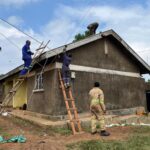Task 237
Assimilation of AMSR-E Soil Moisture Retrievals and Analysis of Soil Moisture Spatial Variability
Principal Investigator(s):
B. Li
Sponsor(s):
D. Toll
Last Updated:
October 26, 2012 15:26:04
Description of Problem
Terrestrial water storage (TWS), which includes soil moisture, groundwater, surface water and snow, is an important hydrological indicator and can be used to infer the potential for future hydrological stress (drought). The state of TWS is also directly linked to other aspects of the hydrological cycle such as infiltration rates and subsurface flow. Large uncertainty exists in model estimated TWS due to uncertainties in forcing, model parameters and inadequacies in model physics. The TWS variations as observed by the Gravity Recovery and Climate Experiment (GRACE) satellites, which is the only satellite mission that monitors the water storage changes in the Earth’s vertical profile, can be used to nudge model estimates towards the truth so that more objective estimates of TWS can be achieved.
Scientific Objectives and Approach
Because of the coarser temporal and spatial scale of GRACE data, data assimilation is the ideal approach to seamlessly merge GRACE observations with high resolution model estimates. An ensemble Kalman smoother (EnKS) developed earlier in the NASA group led by M. Rodell was applied to the NASA Catchment model.
Accomplishments
The study was conducted in western and central Europe where diverse climate and hydrological conditions exist. An open loop (OL) and a GRACE data assimilation (DA) run were performed for the 2002-2009 period to demonstrate the effect GRACE data assimilation on modeled states and fluxes. Evaluation results show that GRACE data assimilation improved the runoff correlation in 17 out 18 hydrological basins (Figure 1), even in basins smaller than the effective resolution of GRACE, suggesting the successful downscaling of GRACE TWS. In addition to improving temporal correlations, GRACE data assimilation also reduced increasing trends in simulated monthly TWS and runoff associated with increasing rates of precipitation (Figure 2). Evaluation on soil moisture is less conclusive due to the shortness of in situ measurements. GRACE assimilated root zone soil moisture and TWS fields exhibited significant changes (Figure 3) in their dryness rankings relative to those without data assimilation, suggesting that GRACE data assimilation could have a substantial impact on drought monitoring.
A journal article submitted to J. of Hydrology was reviewed with request for moderate revisions. The results were also presented at 2011 AGU Fall meeting.








